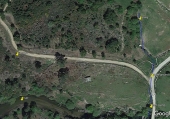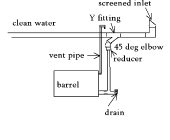




 2
2




'Every time I learn something new, it pushes some old stuff out of my brain.'
 1
1
 1
1




Iterations are fine, we don't have to be perfect
My 2nd Location:Florida HardinessZone:10 AHS:10 GDD:8500 Rainfall:2in/mth winter, 8in/mth summer, Soil:Sand pH8 Flat
 1
1




 The pump is specially designed for river use, so it doesn't clog 'easily' but it certainly does clog. Regularly and at the bottom of a 10m ladder climb down a typhoon wall. I also agree on the ponds - it could be an option to pump into our pond and from there into the water tank. I will use a feeder tank for liquid compost and probably a weekly flood of the ditches would be very helpful. No need for swales on this section as it's very flat and, to be honest, we have a whole season where getting rid of excess water quickly is critical.
The pump is specially designed for river use, so it doesn't clog 'easily' but it certainly does clog. Regularly and at the bottom of a 10m ladder climb down a typhoon wall. I also agree on the ponds - it could be an option to pump into our pond and from there into the water tank. I will use a feeder tank for liquid compost and probably a weekly flood of the ditches would be very helpful. No need for swales on this section as it's very flat and, to be honest, we have a whole season where getting rid of excess water quickly is critical.
 2
2




A human being should be able to change a diaper, plan an invasion, butcher a hog, conn a ship, design a building, write a sonnet, balance accounts, build a wall, set a bone, comfort the dying, take orders, give orders, cooperate, act alone, solve equations, analyze a new problem, pitch manure, program a computer, cook a tasty meal, fight efficiently, die gallantly. Specialization is for insects.
-Robert A. Heinlein











 2
2




'Every time I learn something new, it pushes some old stuff out of my brain.'

 2
2




We have had the water tested and it's pretty good as far as heavy metals go. There are some infrequent fish die offs and it's definitely very turgid with a lot of algae.
The soil content is likewise low in heay metals, but also low in fertility with a pH around 7.5 - we are adding organic compost and animal manure at the time of planting.
I'll go with defining organic in our context rather than speaking about Taiwan in general. It's a meditation and yoga retreat with an emphasis on sentient/yoga diets (no garlic,onion,egg,meat,mushrooms) and we have more than 10 people who live on the property, many volunteers who stay here and also many guests. It's not so realistic in this rural and agricultural environment to be overly demanding about organic purity. I want to do the best I practically can. We generate A LOT of food scraps and make hot compost, we use farm-grown mulch regularly - but it breaks down fast, we use farm-made enyzmes and liquid compost along with commercial organic fertilizers.
I absolutely agree about planting trees and shrubs around the perimeter of the garden.
So, in conclusion, my thoughts for now...
1. Adding a foam sheet around the river pump will help prevent contamination, but will be a nightmare to regularly access and clean.
2. I'm looking at in-line filters, but they also have to be easy to screw in and out and cope with high pressure
3. A slow sand filter appeals to me, but I'm concerned it's not practical with a 20,000L tank to top up and the pump costing quite a lot to run if I reduce the incoming pressure into the tank and thus take much longer to fill it. Ideas?
4. Gravity feeding water down into the 20,000L tank from our lotus pond. Easier to access and filter. Might need to install a float valve
List of Bryant RedHawk's Epic Soil Series Threads We love visitors, that's why we live in a secluded cabin deep in the woods. "Buzzard's Roost (Asnikiye Heca) Farm." Promoting permaculture to save our planet.




![Filename: IMG20181115095759.jpg
Description: Facing W - river is on the left and large tank is at the SW corner of the photo [Thumbnail for IMG20181115095759.jpg]](/t/95821/a/67880/thumb-IMG20181115095759.jpg)
 2
2




It's not so realistic in this rural and agricultural environment to be overly demanding about organic purity. I want to do the best I practically can.
Standing on the shoulders of giants. Giants with dirt under their nails









"The rule of no realm is mine. But all worthy things that are in peril as the world now stands, these are my care. And for my part, I shall not wholly fail in my task if anything that passes through this night can still grow fairer or bear fruit and flower again in days to come. For I too am a steward. Did you not know?" Gandolf






Iterations are fine, we don't have to be perfect
My 2nd Location:Florida HardinessZone:10 AHS:10 GDD:8500 Rainfall:2in/mth winter, 8in/mth summer, Soil:Sand pH8 Flat

|
There is no more Flipper. Call me "Darth Fin" from now on. Or face the wrath of this tiny ad:
Freaky Cheap Heat - 2 hour movie - HD streaming
https://permies.com/wiki/238453/Freaky-Cheap-Heat-hour-movie
|







